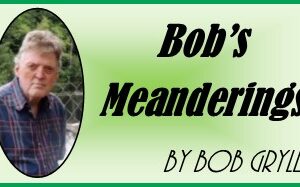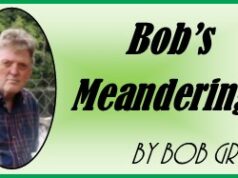A friend recently asked me, “Did you know that oxen cannot stand on three-legs?” Oxen, I thought their habitat was the Himalayas. I said “No.” He said, “Farmers used them around here for clearing land but they disappeared in the early 1800s. “No wonder I didn’t know of them,” I said.
Long before horses, steam engines and tractors, the ox was the power source chosen ploughing and cultivation of land. Oxen were slow, but when there was a need for their strength they pulled with a dogged and steadily manner until the job was completed. They were known as ‘the beast of burden.’
Steers (castrated male cattle) rather than be sold as meat were sometimes trained to become an ox. Oxen were paired for work and had to be carefully matched for size, strength and especially for height. Once a pair was selected they became each other’s companions for life, working side-by-side and never far apart whether grazing in meadows or sleeping in the barn. Then they gradually disappeared – because of industrialization and speed.
Oxen were more robust than horses, less likely to get injured, and in grim times could survive on dreadful food and mouldy hay that no horse would touch. At the end of their working life oxen also made good beef.
The power of working oxen was via a heavy wooden yoke, fitted on top of the neck and in front of the shoulders. The yoke was then held in place by an oxbow, which curved around under the beast’s neck.
Working oxen had to be shod and the cloven hooves involved fitting two half-moon shaped iron shoes on each foot. Oxen are unable to stand on three legs so the ox-shoeing process was difficult. They had to be thrown to the ground or lifted in a sling to get new shoes nailed in place.
Our system of land measurement, with its miles and acres and such, was the direct result of a drove of oxen standing tired in a field after a morning’s plowing more than a thousand years ago.
The furrow length was based the length that oxen could plow before resting. It was found that the pole used to urge the oxen on was measured to be 40 pole lengths of furrow which became standardized as 40 rods or one furlong. The furlong became synonymous with horse racing tracks principally. A furlong was 1/8 of a mile or 660 feet long.
The same friend had been to Upper Canada Village recently and inquired about the oxen who had pulled a sight- seeing wagon around some exhibits on his previous visit.
He was told that the pair of oxen were ready for well-deserved retirement and so were sent to a farm together a year ago. These two didn’t require to be shod as they didn’t do work of clearing land like their forefathers 1,000 years ago.
To regenerate the interest in oxen for their visitors, a pair of male calves were designated for the Village. Once castrated they would arrive and be trained to eventually replace the retired oxen.
Our interest shifted to whether other large animals had to always stand on four-legs like an ox but there weren’t any. Many other animals use a ‘tripod stance’ when at rest because it is stable and requires little energy for them. A truly three-limbed animal does not exist in the World.
Throughout history, elephants have been thought of as ‘different’. Shakespeare, and even Aristotle, described them as on inflexible column-like legs. And this myth persists even today that elephants’ legs work like a four-wheel drive vehicle, making them probably unique in the animal kingdom. Their “four-leg-drive” system means power is applied independently to each limb.
All other four-legged animals are thought to have “rear-leg-drive”, in which the hind legs are used for acceleration while the front legs are used more for braking. “
John Hutchinson, from the Royal Veterinary College in London said, “ We have developed some new techniques for looking at animal movement and found that elephant legs behave in rather strange and distinctive ways.”
In the movements of six young Asian elephants at different speeds, the scientists found that each limb was used for both braking and accelerating. Their legs were shown to be slightly “bouncy”, especially when running fast, which made their legs two to three times less mechanically efficient than expected.
Humans were given two legs, some more pleasant to look at and some unsustainable for as many years as would be liked.





![Kenopic/Smith Auction [Paid Ad]](https://whitewaternews.ca/wp-content/uploads/2018/10/advertising-100x75.jpeg)

